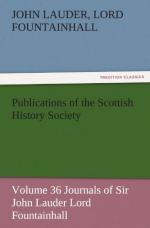[609] Sir John Baird of Newbyth, still pronounced Newbayth.
[610] Torn to pieces.
[611] Clarus, Ant. Sylv., Commentarius ad Leges, etc. Paris, 1603.
[612] Perez, Antonio, Spanish Jurist, 1583-1678.
On the 17 of November 1671, Mr. William Bailzie, Advocat, gave in a complaint on J. Watson of Lammyletham for having abused him, and called him a base rascall and threatning to draw on him. My Lord Newbayth being appointed to examine the witnesses, and having reported the Lords, called him and Mr. William in alone, rebuked him, and commanded him to cary him selfe more soberly in tyme coming.
On the 23 of November 1671, Sir Androw Ramsay of Abbotshall, Lord Provest of Edinburgh for the 10’t year altogither, was received ane ordinar Lord of the Session upon his Majestys letter to that effect, in the place vaicand throw the deceas of Alexander Lord Halkerton, who possest that place of before.
I find in the records of Sederunt about the year 1553 and afterward on Sir William Hamilton[613] of Sanquhar Hamilton a Lord and provest of Edinburgh both at once. I find also that Chancelor Seyton[614] for some years that he was President Fyvie and some years that he was Chancelor (for he was 10 years altogither provest) was also Provest of Edinburgh; but that was at a tyme when the Senators of the Colledge of Justice grasped at the haill power of the toune upon their delinquency and uproar of the 17 of December 1596, for he entred at that tyme when the toune was at their feet, and when they had the approbation and reprobation of the toune their yearly election, but whow soon the toune begane to recover strenth and the memory of that foull slip waxed old they hoised him out; and for fear of the like inconveniency, and to bolt the door theirafter, they procured ane Act of Parliament in Anno 1609 (Vid. the 8’t Act), declaring that no man shall in tyme coming be capable of provestrie or magistracy but merchants and actuall traffiquers duelling within burgh. Its true Sir John Hay (who was at first toun Clerk of Edinburgh) when he was Clerk Register




